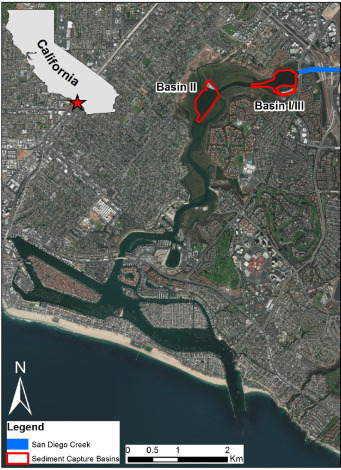
A NOAA-funded study in Southern California has identified a tipping point where a coastal embayment, once overburdened with sediment, will require increased sediment loading to keep pace with rising sea levels and avoid inundation. The sediment that washes from our urban and rural lands into streams from soil erosion can lead to poor water quality and degraded ecosystems. Across the U.S., programs have been put into place under the authority of Total Maximum Daily Load (TMDL) regulations set forth by the Clean Water Act to reduce the sediment fluxes into streams and improve water quality and address ecosystem impairments. Matching watershed supplies of sediment to rates of sea level rise will be important to ensure healthy coastal marshes for decades into the future, and this calls for a careful re-examination of sediment source control measures that have worked for decades to reduce sediment fluxes into water bodies.
In Newport Bay, the Orange County Department of Public Works coordinates regional National Pollutant Discharge Elimination System stormwater and TMDL compliance efforts on behalf of the County, Orange County Flood Control District, and the cities of Orange County. By identifying Newport Bay as a potentially sediment-deficient environment, municipal staff and regulators are revisiting future sediment management planning strategies, which have historically cost more than $200 million dollars over nearly 4 decades for Newport Bay and San Diego Creek related to the Sediment TMDL.
Chris Crompton, Manager of the North Orange County Watershed Management Area for OC Public Works during the study, shared that, “Through the project, the County has learned that a large percentage of the Southern California coast is sediment deficient, requiring regulators and local jurisdictions to rethink about sediment generation, transport, and beneficial use issues that may fundamentally change the way infrastructure is designed, built, and maintained.”
This groundbreaking study has recently come to a close. The project advanced models that link scenarios of sediment management with resultant effects on natural infrastructure (e.g., beaches and wetlands), then assess vulnerability of the region to sea level rise and extreme weather events under the scenario. These tools are enabling the analysis of flood risk, including compound flooding, sediment instability and erosion risk, and habitat distribution afforded by alternative sediment management practices and beneficial use of dredged sediment, as well as helping others explore opportunities to finance watershed management projects. The outcomes of this project were only achievable due to direct collaboration between universities, research institutions, and local stakeholders.
These findings are an outcome of an NCCOS Effects of Sea Level Rise (ESLR) project led by the University of California, Irvine which examined the role of sediment management policies and practices on inundation risks to coastal wetlands and human development in Newport Bay Estuary and Tijuana River Estuary of Southern California.
Citation: Brand, M.W., Guo, L., Stein, E.D., and Sanders, B.F. 2021. Multi-decadal simulation of estuarine sedimentation under sea level rise with a response-surface surrogate model. Advances in Water Resources 150; 103876. https://doi.org/10.1016/j.advwatres.2021.103876
